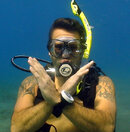Yes, I do. I'm adding another attachment point from my camera to my BP/W (XDeep Zeos for cold water, Ghost for warm). Now if that breaks, I don't know it anymore. Normally, I clip it onto one of the D rings on my left side. I'll let it hang a little bit, but sometimes I have to grab the camera so that the viewfinder doesn't get banged around. I can't flip it around, as I don't want to scratch the port. Now when I get a dome port for my 24 mm lens, then I have to be more careful for it to not get scratched. I'll try that new lanyard you see in the picture below with the suicide clips and encased cable to have it hang down from the D-ring on my croctch strap. That should probably work. I'll just unclip from the left side of my harness and clip onto the D-ring on my crotch strap.
And yes, I often inflate my DSMB from my bladder via the low pressure inflator hose when I'm floating midwater so I maintain depth (safety stops are not exciting). Over the weekend, the boat captain gave me some tips if I ever dive Galloping Gerdie, the old Tacoma Narrows bridge (you have seen the film in physics class). Basically he said, be on the sea floor, blast air into the DSMB, let it fly, then at some point, let the reel clamp on, so that you get yanked up at least 20' so you clear all the metal posts that stick up 20 feet. You don't want to hit one of those while drifting in a 5 naut current. So of course I'll practice this without my camera, at probably 100' or so, in a calm conditions.View attachment 215467
If you go from 100 to 80 in a hurry you may make the rest of the trip up.






